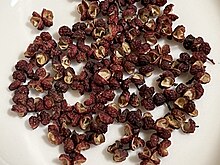
Back فلفل سشوان Arabic فلفل سيشوان ARZ Съчуански пипер Bulgarian Pebre de Sichuan Catalan Pepř sečuánský Czech Szechuanpfeffer German Siĉuan-pipro Esperanto Sichuani pipar Estonian فلفل سیچوآن Persian Poivre de Sichuan French
| Sichuan pepper | |||||||||||||||||||||||||
|---|---|---|---|---|---|---|---|---|---|---|---|---|---|---|---|---|---|---|---|---|---|---|---|---|---|
 | |||||||||||||||||||||||||
| Chinese | 花椒 | ||||||||||||||||||||||||
| Literal meaning | Flower pepper | ||||||||||||||||||||||||
| |||||||||||||||||||||||||
Sichuan pepper (Chinese: 花椒; pinyin: huājiāo; Nepali: टिमुर, romanized: timur), also known as Sichuanese pepper, Szechuan pepper, Chinese prickly ash, Chinese pepper, Mountain pepper, and mala pepper, is a spice commonly used in Sichuan cuisine in China, in Nepal, and in northeast India. Despite its name, Sichuan pepper is not closely related to black pepper or chili peppers. It is made from plants of the genus Zanthoxylum in the family Rutaceae, which includes citrus and rue.[1]
When eaten, Sichuan pepper produces a tingling, numbing effect due to the presence of hydroxy-alpha sanshool.[2] The spice has the effect of transforming other flavors tasted together or shortly after. It is used in Sichuan dishes such as mapo doufu and Chongqing hot pot, and is often added together with chili peppers to create a flavor known as málà (Chinese: 麻辣; 'numb-spiciness').
- ^ Zhang, Mengmeng; Wang, Jiaolong (October 2017). "Zanthoxylum bungeanum Maxim. (Rutaceae): A Systematic Review of Its Traditional Uses, Botany, Phytochemistry, Pharmacology, Pharmacokinetics, and Toxicology". International Journal of Molecular Sciences. 18 (10): 2172. doi:10.3390/ijms18102172. PMC 5666853. PMID 29057808. S2CID 1057880.
- ^ Holliday, Taylor (23 October 2017). "Where the Peppers Grow". Slate.com. Retrieved 15 October 2020.